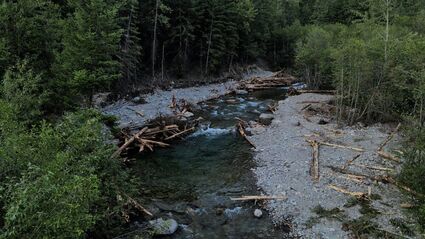Volunteers needed for Vermilion floodplain restoration
October 21, 2021

Josh Boyd
Placed wood structures and rock create in-stream complexity in the Vermilion River, while the newly constructed floodplain uses wood that will capture fine sediment during runoff and promote natural regeneration of native plants.
Volunteers are invited to help plant trees and shrubs along the Vermilion River this fall, following the reconstruction of a portion of the river's floodplain. A 2,400-foot stretch of the river was the site of floodplain reconstruction this summer under a collaborative project of the Kootenai National Forest (KNF), Lower Clark Fork Watershed Group (LCFWG), Green Mountain Conservation District, Montana Fish, Wildlife & Parks, and Avista. The "Sims Meander" stretch of the river was recontoured to reconnect the river to the floodplain, and large logs and root wads were installed along the banks of the river and in the floodplain to anchor the banks and help trap sediment during flood events. These measures were designed to help restore native vegetation in the floodplain and slow water during runoff events. That in turn will improve water quality and improve habitat for native fish and wildlife.
The conservation district hired Elk Creek Contracting to do the construction work. KNF hydrologists worked closely with Elk Creek to ensure that the in-stream and floodplain work closely followed technical designs, said Brita Olson, LCFWG Coordinator. "Over time, this project is expected to improve the health and resiliency of the Vermilion River, by restoring floodplain function and promoting natural vegetation recruitment," Olson said. "The increased complexity – provided in part by the large wood in the river – will provide pools, cover, and help deposit spawning gravel for native fish." The Vermilion River provides habitat for a variety of fish and other aquatic and terrestrial species. They include bull trout (listed as threatened under the Endangered Species Act) and Westslope cutthroat trout (Montana species of special concern). The construction work began in July and continued in August (under a Stage II fire permit). The Thorne Creek Fire (part of the West Lolo Complex) burned over a ridge from the Vermilion River, but ultimately did not interfere with the restoration work. In late October, the team is scheduled to undertake a major planting effort to restore native vegetation in the floodplain, led by the KNF. Volunteers can assist in this effort, and should be prepared for strenuous work in variable weather conditions planting native trees in coarse gravel and cobble.
Eventually, the planted trees will provide shade and stability for the river and floodplain – as well as habitat for wildlife. "While we plant a lot of trees to accelerate the recovery of the project reach, ultimately the river will benefit from natural recruitment because of this work," Olson said. "Throughout previously restored reaches, we are seeing fine sediment deposition in the floodplain which was formally dry, coarse cobble supporting little more than the noxious Spotted Knapweed. Along with fine sediment comes native forbes like Indian Paint, Pearly Everlasting, and Silverleaf Phacelia as well as natural conifer regeneration."
The Sims Meander project, which is about 10.5 miles upstream from the confluence with the Noxon Reservoir, is the third of a series of stream restoration projects in the Vermilion River, beginning with the Chapel Hill Slide reach in 2012 and 2013, and followed by the Miners Gulch reach in 2016 and 2017. Additional projects have been identified by the KNF, and are expected to be implemented over the next few decades. Collectively, this series of projects will address impacts to the river from historic mining and removal of floodplain vegetation prior to streamside management zone laws.
"The collective restoration of watershed values and water quality, critical habitat for threatened bull trout and Sensitive Westslope cutthroat trout, and restoration of riparian habitat through the Chapel Hill Slide, Miners Gulch, and now Sims Meander project achieves restoration objectives outlined in the Kootenai Forest Plan," said Michael Feiger, District Ranger for the Cabinet Ranger District. "These actions benefit not only the aquatic and riparian resources that are improved, but also the many users of the Vermilion River that benefit from improved water quality and habitat."
The projects have been funded through multiple federal and state grants, and funding from the U.S. Forest Service and Avista. This year's Sims Meander project benefited from a $200,000 grant from the Montana Department of Environmental Quality's 319 Project Program."The Cabinet Ranger District and Kootenai National Forest greatly appreciate the collaborative work with the partners in achieving the restoration objectives that serve our collective organizations and the public that enjoy the Vermilion," said Ranger Michael Feiger.
For more information about the Vermilion River restoration efforts, visit lcfwg.org. To volunteer for the revegetation planting effort this fall, contact Brita Olson at [email protected] or (208) 304-3852.





Reader Comments(0)